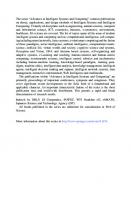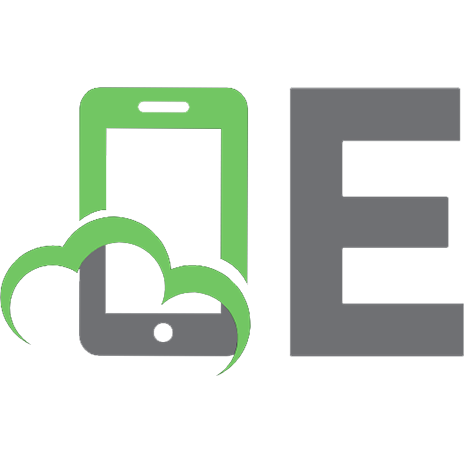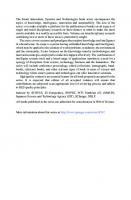Internet Computing: Principles of Distributed Systems and Emerging Internet-Based Technologies 9783030349561, 9783030349578, 303034956X
This book introduces the reader to the fundamentals of contemporary, emerging and future technologies and services in In
137 114 5MB
English Pages 431 [426]
Table of contents :
Preface
Contents
Abbreviations
Chapter 1: Introduction to Internet Computing
1.1 A Brief History of the Internet
1.1.1 Phase I: Development of Technological Fundamentals
1.1.2 Phase II: Growth and Internationalization
1.1.3 Phase III: Commercialization and the World Wide Web
1.2 Defining Internet Computing
1.2.1 Applications
1.2.2 Architectures
1.2.3 Technologies
1.2.4 Systemic Matters
1.3 Distributed Information Systems for Internet Computing
1.3.1 Distributed Systems
1.3.2 Information Systems
1.3.3 Design Challenges of Distributed Information Systems
1.4 Application Examples of Internet Computing
Summary
Questions
References
Further Reading
Chapter 2: Information Systems Architecture
2.1 Defining Information Systems Architecture
2.2 The Principles of Information System Architecture
2.2.1 Principle 1: Architecture Models Information System Boundaries, Inputs, and Outputs
2.2.2 Principle 2: An Information System Can Be Broken down into a Set of Smaller Subsystems
2.2.3 Principle 3: An Information System Can Be Considered in Interaction with Other Systems
2.2.4 Principle 4: An Information System Can Be Considered Through Its Entire Lifecycle
2.2.5 Principle 5: An Information System Can Be Linked to Another Information System via an Interface
2.2.6 Principle 6: An Information System Can Be Modeled at Various Abstraction Levels
2.2.7 Principle 7: An Information System Can Be Viewed Along Several Layers
2.2.8 Principle 8: An Information System Can Be Described Through Interrelated Models with Given Semantics
2.2.9 Principle 9: An Information System Can Be Described Through Different Perspectives
2.3 Architectural Views
2.4 Architectural Patterns
2.4.1 Client-Server Architectures
2.4.2 Tier Architectures
2.4.3 Peer-to-Peer Architectures
2.4.4 Model View Controller Architectures
2.4.5 Service-Oriented Architecture
Summary
Questions
References
Further Reading
Chapter 3: Design of Good Information Systems Architectures
3.1 Architecture Design
3.2 IS Architectures' Quality
3.2.1 Functional and Nonfunctional Requirements
3.2.2 Quality Attributes
3.3 The Information Systems Architecture Design Process
3.3.1 Basic Process Activities
3.3.2 Example Method for Designing Architectures: Attribute-Driven Design (ADD) Method
3.3.3 Success of Architecture Design Processes: The Iron Triangle
Summary
Questions
References
Further Reading
Chapter 4: Internet Architectures
4.1 History of the Internet
4.2 Today´s Internet Network Infrastructure
4.3 The Internet Protocol
4.3.1 Internet Protocol Suite
4.3.2 IP Addresses
4.3.3 Domain Name System
4.3.4 IP-Routing and Packet Forwarding
4.4 Content Delivery Networks
4.5 Emerging Internet Network Architecture
4.5.1 Software-Defined Networking
4.5.2 Network Functions Virtualization
4.5.3 Overlay Networks
4.5.4 Information-Centric Networking
Summary
Questions
References
Further Reading
Chapter 5: Middleware
5.1 Introduction to Middleware
5.2 Remote Procedure Call
5.3 Middleware Categories
5.3.1 Message-Oriented Middleware
5.3.2 Transaction-Oriented Middleware
5.3.3 Object-Oriented Middleware
Summary
Questions
References
Further Reading
Chapter 6: Web Services
6.1 Introduction to Web Services
6.2 Basic Web Technologies
6.2.1 Hyper Text Transfer Protocol (HTTP)
6.2.2 Extensible Markup Language (XML)
6.3 Web Service Architectures
6.3.1 Service-Oriented Architecture
6.3.2 Internal and External Web Service Architecture Perspectives
6.3.3 SOAP Web Services
6.3.4 RESTful Web Services
6.3.5 Differentiating Between RESTful and SOAP Web Services
Summary
Questions
References
Further Reading
Chapter 7: Cloud Computing
7.1 An Introduction to Cloud Computing
7.1.1 The Emergence of Cloud Computing
7.1.2 Definition of Cloud Computing and its Essential Characteristics
7.1.3 The Cloud Service Market
7.1.4 Cloud Computing Service Models
7.1.5 Cloud Computing Deployment Models
7.1.6 Differences Between Related Concepts
7.2 Essentials to the Provision of Cloud Services
7.2.1 Essential Cloud Technologies
7.2.2 Cloud Service Stack
7.3 Chances and Challenges of Cloud Computing
7.3.1 Reasons to Move into the Cloud: Benefits and Opportunities for Organizations
7.3.2 Cloud Computing´s Transformative Mechanisms
7.3.3 The Downside of Cloud Computing: New Risks and Challenges
7.4 Security and Data Protection in Cloud Environments
7.4.1 Security and Privacy Challenges Due to Essential Cloud Service Characteristics
7.4.2 Continuous Service Certification as Innovative Means to Ensure Security and Data Protection
Summary
Questions
References
Further Reading
Chapter 8: Fog and Edge Computing
8.1 Fog and Edge Computing Fundamentals
8.1.1 Definition and Characteristics of Fog Computing
8.1.2 Fog Computing Service Models
8.1.3 Fog Computing Deployment Models
8.1.4 Definition and Characteristics of Edge Computing
8.1.5 Mist Computing
8.1.6 Differences to Cloud Computing
8.2 Challenges and Opportunities of Fog and Edge Computing
8.2.1 Challenges of Fog and Edge Computing
8.2.2 Opportunities
8.3 Fog and Edge Computing in Practice
8.3.1 OpenFog Reference Architecture for Fog Computing
8.3.2 Video Analytics
8.3.3 Augmented Reality Glasses
Summary
Questions
References
Further Reading
Chapter 9: Distributed Ledger Technology
9.1 Background of Distributed Ledger Technology
9.1.1 Distributed Ledger Technology as a Game Changer
9.1.2 History of Distributed Ledger Technology
9.1.3 Terminology in Distributed Ledger Technology
9.2 Technical Foundations
9.2.1 Hash Functions
9.2.2 Merkle Tree
9.2.3 Public Key Infrastructure
9.2.4 Consensus Mechanisms in Distributed Ledger Technology
9.3 The Bitcoin Blockchain
9.4 Smart Contracts
9.5 Applications of Distributed Ledger Technology
9.5.1 Financial Technology
9.5.2 Health Care
9.5.3 Supply Chain Management
Summary
Questions
References
Further Reading
Chapter 10: The Internet of Things
10.1 Introduction of the Internet of Things
10.1.1 Definition and Characteristics
10.1.2 A Brief History of the Internet of Things
10.2 The Internet of Things: Technologies and Architectures
10.2.1 Enabling Technologies
10.2.2 Core Concepts
10.2.3 Architecture Models
10.3 Internet of Things Applications
10.3.1 Smart Homes
10.3.2 Smart Cities
10.3.3 The Industrial Internet of Things
10.3.4 The Internet of Things in the Energy and Health Care Sectors
10.4 Challenges and the Future of the Internet of Things
10.4.1 Challenges
10.4.2 Outlook: The Future of the Internet of Things
Summary
Questions
References
Further Reading
Chapter 11: Critical Information Infrastructures
11.1 Foundations of Critical Information Infrastructures
11.1.1 The Emergence of Critical Information Infrastructures
11.1.2 Sociotechnical Systems
11.1.3 Conceptualization of Critical Information Infrastructures
11.1.4 Differences Between Critical Infrastructures and Critical Information Infrastructures
11.2 Properties of Critical Information Infrastructures
11.3 Functions of Critical Information Infrastructures
11.3.1 Communication
11.3.2 Governance
11.3.3 Knowledge Management
11.3.4 Information Collection
11.4 Operation of Critical Information Infrastructures
Summary
Questions
References
Further Reading
Chapter 12: Emerging Technologies
12.1 Emergence and Emerging Technology
12.2 Immersive Technologies
12.2.1 Virtual Reality
12.2.2 Augmented Reality
12.3 Virtual Assistant
12.4 Artificial Intelligence
Summary
Questions
References
Further Reading
Glossary
Preface
Contents
Abbreviations
Chapter 1: Introduction to Internet Computing
1.1 A Brief History of the Internet
1.1.1 Phase I: Development of Technological Fundamentals
1.1.2 Phase II: Growth and Internationalization
1.1.3 Phase III: Commercialization and the World Wide Web
1.2 Defining Internet Computing
1.2.1 Applications
1.2.2 Architectures
1.2.3 Technologies
1.2.4 Systemic Matters
1.3 Distributed Information Systems for Internet Computing
1.3.1 Distributed Systems
1.3.2 Information Systems
1.3.3 Design Challenges of Distributed Information Systems
1.4 Application Examples of Internet Computing
Summary
Questions
References
Further Reading
Chapter 2: Information Systems Architecture
2.1 Defining Information Systems Architecture
2.2 The Principles of Information System Architecture
2.2.1 Principle 1: Architecture Models Information System Boundaries, Inputs, and Outputs
2.2.2 Principle 2: An Information System Can Be Broken down into a Set of Smaller Subsystems
2.2.3 Principle 3: An Information System Can Be Considered in Interaction with Other Systems
2.2.4 Principle 4: An Information System Can Be Considered Through Its Entire Lifecycle
2.2.5 Principle 5: An Information System Can Be Linked to Another Information System via an Interface
2.2.6 Principle 6: An Information System Can Be Modeled at Various Abstraction Levels
2.2.7 Principle 7: An Information System Can Be Viewed Along Several Layers
2.2.8 Principle 8: An Information System Can Be Described Through Interrelated Models with Given Semantics
2.2.9 Principle 9: An Information System Can Be Described Through Different Perspectives
2.3 Architectural Views
2.4 Architectural Patterns
2.4.1 Client-Server Architectures
2.4.2 Tier Architectures
2.4.3 Peer-to-Peer Architectures
2.4.4 Model View Controller Architectures
2.4.5 Service-Oriented Architecture
Summary
Questions
References
Further Reading
Chapter 3: Design of Good Information Systems Architectures
3.1 Architecture Design
3.2 IS Architectures' Quality
3.2.1 Functional and Nonfunctional Requirements
3.2.2 Quality Attributes
3.3 The Information Systems Architecture Design Process
3.3.1 Basic Process Activities
3.3.2 Example Method for Designing Architectures: Attribute-Driven Design (ADD) Method
3.3.3 Success of Architecture Design Processes: The Iron Triangle
Summary
Questions
References
Further Reading
Chapter 4: Internet Architectures
4.1 History of the Internet
4.2 Today´s Internet Network Infrastructure
4.3 The Internet Protocol
4.3.1 Internet Protocol Suite
4.3.2 IP Addresses
4.3.3 Domain Name System
4.3.4 IP-Routing and Packet Forwarding
4.4 Content Delivery Networks
4.5 Emerging Internet Network Architecture
4.5.1 Software-Defined Networking
4.5.2 Network Functions Virtualization
4.5.3 Overlay Networks
4.5.4 Information-Centric Networking
Summary
Questions
References
Further Reading
Chapter 5: Middleware
5.1 Introduction to Middleware
5.2 Remote Procedure Call
5.3 Middleware Categories
5.3.1 Message-Oriented Middleware
5.3.2 Transaction-Oriented Middleware
5.3.3 Object-Oriented Middleware
Summary
Questions
References
Further Reading
Chapter 6: Web Services
6.1 Introduction to Web Services
6.2 Basic Web Technologies
6.2.1 Hyper Text Transfer Protocol (HTTP)
6.2.2 Extensible Markup Language (XML)
6.3 Web Service Architectures
6.3.1 Service-Oriented Architecture
6.3.2 Internal and External Web Service Architecture Perspectives
6.3.3 SOAP Web Services
6.3.4 RESTful Web Services
6.3.5 Differentiating Between RESTful and SOAP Web Services
Summary
Questions
References
Further Reading
Chapter 7: Cloud Computing
7.1 An Introduction to Cloud Computing
7.1.1 The Emergence of Cloud Computing
7.1.2 Definition of Cloud Computing and its Essential Characteristics
7.1.3 The Cloud Service Market
7.1.4 Cloud Computing Service Models
7.1.5 Cloud Computing Deployment Models
7.1.6 Differences Between Related Concepts
7.2 Essentials to the Provision of Cloud Services
7.2.1 Essential Cloud Technologies
7.2.2 Cloud Service Stack
7.3 Chances and Challenges of Cloud Computing
7.3.1 Reasons to Move into the Cloud: Benefits and Opportunities for Organizations
7.3.2 Cloud Computing´s Transformative Mechanisms
7.3.3 The Downside of Cloud Computing: New Risks and Challenges
7.4 Security and Data Protection in Cloud Environments
7.4.1 Security and Privacy Challenges Due to Essential Cloud Service Characteristics
7.4.2 Continuous Service Certification as Innovative Means to Ensure Security and Data Protection
Summary
Questions
References
Further Reading
Chapter 8: Fog and Edge Computing
8.1 Fog and Edge Computing Fundamentals
8.1.1 Definition and Characteristics of Fog Computing
8.1.2 Fog Computing Service Models
8.1.3 Fog Computing Deployment Models
8.1.4 Definition and Characteristics of Edge Computing
8.1.5 Mist Computing
8.1.6 Differences to Cloud Computing
8.2 Challenges and Opportunities of Fog and Edge Computing
8.2.1 Challenges of Fog and Edge Computing
8.2.2 Opportunities
8.3 Fog and Edge Computing in Practice
8.3.1 OpenFog Reference Architecture for Fog Computing
8.3.2 Video Analytics
8.3.3 Augmented Reality Glasses
Summary
Questions
References
Further Reading
Chapter 9: Distributed Ledger Technology
9.1 Background of Distributed Ledger Technology
9.1.1 Distributed Ledger Technology as a Game Changer
9.1.2 History of Distributed Ledger Technology
9.1.3 Terminology in Distributed Ledger Technology
9.2 Technical Foundations
9.2.1 Hash Functions
9.2.2 Merkle Tree
9.2.3 Public Key Infrastructure
9.2.4 Consensus Mechanisms in Distributed Ledger Technology
9.3 The Bitcoin Blockchain
9.4 Smart Contracts
9.5 Applications of Distributed Ledger Technology
9.5.1 Financial Technology
9.5.2 Health Care
9.5.3 Supply Chain Management
Summary
Questions
References
Further Reading
Chapter 10: The Internet of Things
10.1 Introduction of the Internet of Things
10.1.1 Definition and Characteristics
10.1.2 A Brief History of the Internet of Things
10.2 The Internet of Things: Technologies and Architectures
10.2.1 Enabling Technologies
10.2.2 Core Concepts
10.2.3 Architecture Models
10.3 Internet of Things Applications
10.3.1 Smart Homes
10.3.2 Smart Cities
10.3.3 The Industrial Internet of Things
10.3.4 The Internet of Things in the Energy and Health Care Sectors
10.4 Challenges and the Future of the Internet of Things
10.4.1 Challenges
10.4.2 Outlook: The Future of the Internet of Things
Summary
Questions
References
Further Reading
Chapter 11: Critical Information Infrastructures
11.1 Foundations of Critical Information Infrastructures
11.1.1 The Emergence of Critical Information Infrastructures
11.1.2 Sociotechnical Systems
11.1.3 Conceptualization of Critical Information Infrastructures
11.1.4 Differences Between Critical Infrastructures and Critical Information Infrastructures
11.2 Properties of Critical Information Infrastructures
11.3 Functions of Critical Information Infrastructures
11.3.1 Communication
11.3.2 Governance
11.3.3 Knowledge Management
11.3.4 Information Collection
11.4 Operation of Critical Information Infrastructures
Summary
Questions
References
Further Reading
Chapter 12: Emerging Technologies
12.1 Emergence and Emerging Technology
12.2 Immersive Technologies
12.2.1 Virtual Reality
12.2.2 Augmented Reality
12.3 Virtual Assistant
12.4 Artificial Intelligence
Summary
Questions
References
Further Reading
Glossary

- Author / Uploaded
- Ali Sunyaev

![Distributed computing: principles, algorithms, and systems [1 ed.]
9780521876346, 0521876346](https://ebin.pub/img/200x200/distributed-computing-principles-algorithms-and-systems-1nbsped-9780521876346-0521876346.jpg)


![Distributed computing: principles, algorithms, and systems [1 ed.]
0521876346, 9780521876346](https://ebin.pub/img/200x200/distributed-computing-principles-algorithms-and-systems-1nbsped-0521876346-9780521876346.jpg)


![Principles of distributed database systems [4 ed.]
9783030262525, 9783030262532](https://ebin.pub/img/200x200/principles-of-distributed-database-systems-4nbsped-9783030262525-9783030262532.jpg)
![Distributed Systems: Principles and Paradigms [2 ed.]
933254980X, 9780132392273](https://ebin.pub/img/200x200/distributed-systems-principles-and-paradigms-2nbsped-933254980x-9780132392273.jpg)
